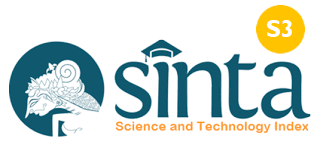Pengembangan Media Pembelajaran Interaktif Berbasis Adobe Flash Professional CS6 Pada Program Studi Sastra Agama Dan Pendidikan Bahasa Bali STAHN Mpu Kuturan Singaraja
DOI:
https://doi.org/10.37329/cetta.v5i1.1443Keywords:
Learning Media Development, Adobe Flash Professional CS6 EducationAbstract
Education in Indonesia in March 2020 experienced significant turmoil, this was due to the pandemic caused by Covid-19. Learning that was initially carried out face-to-face, was then carried out online by applying or using more effective learning media. One of them is by using Adobe Flash Professional CS6. The researcher uses a Research and Development (R&D) model with a 4-D (four D) model through the development stages including Define, Design, Develop, and Disseminate. The results showed that the media feasibility level which was validated by equipment experts showed a feasibility level with a percentage of 88.75%. Meanwhile, the feasibility level of the material expert shows the feasibility level with a percentage of 93.75%. The responses given by educators and students are carried out by conducting product trials, then educators and students are asked to fill out a questionnaire using the google form application. As for the results in terms of educators responding with a percentage of 83.13% satisfying and from students getting a response with a percentage of 80.61% satisfactory.
References
Aeni, A. N. (2014). Pendidikan Karakter Untuk Siswa SD Dalam Perspektif Islam. Universitas Pendidikan Indonesia: Mimbar Sekolah Dasar , 50.
Anwar, D. (2003). Kamus Besar Bahasa Indonesia. Indonesia/ Surabaya: Amelia.
Arikunto, S. Suhardjono. Supardi. (2006). Penelitian Tindakan Kelas. Jakarta: PT. Bumi Aksara.
Azwar, S. (2003). Metode Penelitian. Yogyakarta: Pustaka Pelajar.
Bungin, B. (2001). Metodologi Penelitian Sosial. Surabaya: Airlangga University Press.
Buzan, B. (2010). Culture and International Society. International Affairs Volume 86 , 5.
Cholid, Narboko. DKK. (2002). Metode Penelitian. Jakarta: Bumi Aksara.
Hasan, I. (2002). Pokok-pokok Metodologi Penelitian dan Aplikasinnya. Bandung: Ghalia Indonesia.
Heinich, R. et al. (1996). Instructional Media and Technologies For Learning. New Jersey: Prentice-Hall Inc.
Herayanti, Lovy. Fuaddunnazmi, M. Habibi. (2017). Pengembangan Media pembelajaran interaktif berbasis Moodle Pada Mata Kuliah Fisika Dasar . Cakrawala Pendidikan , 215-218.
Kompri. (2016). Motivasi Pembelajaran Perspektif Guru dan Siswa. Bandung: Rosda.
Lubis, Isma Ramadhani. Ikhsan, Jaslin. (2015). Pengembangan Media Pembelajaran Kimia Berbasis Android Untuk Meningkatkan Motivasi Belajar Dan Prestasi Kognitif Peserta Didik SMA. Jurnal Inovasi Pendidikan IPA, Volume 1, No. 2 , 5-7.
Madcoms. (2012). Adobe Flash Professional CS6 Untuk Pemula. Indonesia/ Yogyakarta: Andi, Madiun: Madcoms.
Madcoms. (2012). Kupas Tuntas Adobe Flash Professional CS6. Indonesia/ Yogyakarta: Penerbit Andi .
Mardapi, D. (2008). Teknik Penyusunan Instrumen Tes Dan Non Tes. Yogyakarta: Mitra Cendikia Press.
Mulyanto, A. (2009). Sistem Informasi Konsep dan Aplikasi. Yogyakarta: Pustaka Pelajar.
Novak, J. D., Gowin, D. B., Johansen, G. T. (1983). The Use of Concept Mapping and Knowledge Vee Mapping with Junior High School Science Students. Science Education , 1.
Richey, Rita C. Klein, James D. (2007). Design and Development Research Methods, Strategies and Issues. Routledge: Lawrence Erbaum Associates, Inc.
Sax, G. (1989). Principles of Educational and Psychological Measurement and Evaluation. Belmont California: Wads Worth Pub.
Seta, A. K. (1987). Konservasi Sumber Daya Tanah dan Air. Jakarta: Kalam Mulia.
Setyosari, P. (2010). Metode Penelitian Pendidikan dan Pengembangan. Jakarta: Kencana.
Sudaryono, D. (2019). Metodologi Penelitian Kuantitatif, Kualitatif, dan Mix Method. Depok: Rajawali Pers.
Sudikan, S. Y. (2001). Metode Penelitian Sastra Lisan. Surabaya: Citra Wacana.
Sugiyono. (2020). Metode Penelitian Kuantitatif, Kualitatif, dan R&D. Bandung: Alfabeta.
Suissa, J. (2015). Character Education and the Disappearance of The Political. London: Institute of Education.
Supardi. (2006). Metodologi Penelitian. Mataram: Yayasan Cerdas Press.
Suparman, M. A. (1997). Model-model Pembelajaran Interaktif. Jakarta: STIA-LAN .
Thiagarajan, S. Semmel, D.S. Semmel, M.I. . (1974). Instructional Development for Training Teacher of Exceptional Children. Bloomington Indiana: Indiana University.
Trianto. (2011). Model Pembelajaran Terpadu Konsep Strategi Dan Implementasinya Dalam Kurikulum Tingkat Satuan Pendidikan. Jakarta: Bumi Aksara.
V.S. Gerlach. D.P. Ely. (1971). Teaching and Media: A Systematic Approach . Boston: Prentice-Hall.
Wahyuningsih, A. N. (2011). Pengembangan Media Komik Bergambar Materi Sistem Saraf Untuk Pembelajaran Yang Menggunakan Strategi Pq4r. Universitas Negeri Semarang. Jurnal PP. Volume 1, No. 2 , 105-107.
Waryanto, N. H. (2006). Teknik Dasar Macromedia Flash. Yogyakarta: Laboratorium Komputer Jurusan Pendidikan Matematika Universitas Negeri Yogyakarta.
Wicaksono, S. R. (2011). Rekayasa Perangkat Lunak. Malang: Seribu Bintang.
Downloads
Published
How to Cite
Issue
Section
License
Copyright (c) 2022 I Nengah Adi Widana, I Nengah Juliawan, Made Suardika Jaya, I Wayan Juliana

This work is licensed under a Creative Commons Attribution-ShareAlike 4.0 International License.
An author who publishes in the Cetta : Jurnal Ilmu Pendidikan agrees to the following terms:
- Author retains the copyright and grants the journal the right of first publication of the work simultaneously licensed under the Creative Commons Attribution-ShareAlike 4.0 License that allows others to share the work with an acknowledgement of the work's authorship and initial publication in this journal
- Author is able to enter into separate, additional contractual arrangements for the non-exclusive distribution of the journal's published version of the work (e.g., post it to an institutional repository or publish it in a book) with the acknowledgement of its initial publication in this journal.
- Author is permitted and encouraged to post his/her work online (e.g., in institutional repositories or on their website) prior to and during the submission process, as it can lead to productive exchanges, as well as earlier and greater citation of the published work (See The Effect of Open Access).
Read more about the Creative Commons Attribution-ShareAlike 4.0 Licence here: https://creativecommons.org/licenses/by-sa/4.0/.





